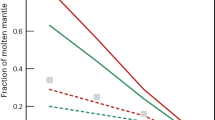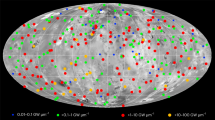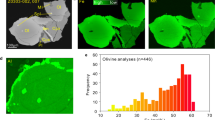Abstract
A strong volcanic plume consists of a vertical column of hot gases and dust topped with a horizontal ‘umbrella’1. The column rises, buoyed by entrained and heated ambient air, reaches the neutral-buoyancy level, then spreads radially to form the umbrella. In classical models of strong volcanic plumes, the plume is assumed to remain always axisymmetric and non-rotating. Here we show that the updraught of the rising column induces a hydrodynamic effect not addressed to date—a ‘volcanic mesocyclone’. This volcanic mesocyclone sets the entire plume rotating about its axis, as confirmed by an unprecedented analysis of satellite images from the 1991 eruption of Mount Pinatubo2,3,4. Destabilized by the rotation, the umbrella loses axial symmetry and becomes lobate in plan view, in accord with satellite records of recent eruptions on Mounts Pinatubo, Manam, Reventador, Okmok, Chaiten and Ruang. The volcanic mesocyclone spawns waterspouts5,6 or dust devils6,7,8, as seen in numerous eruptions, and groups the electric charges about the plume to form the ‘lightning sheath’ that was so prominent in the recent eruption of Mount Chaiten. The concept of a volcanic mesocyclone provides a unified explanation for a disparate set of poorly understood phenomena in strong volcanic plumes5,6,7,8,9,10.
This is a preview of subscription content, access via your institution
Access options
Subscribe to this journal
Receive 51 print issues and online access
$199.00 per year
only $3.90 per issue
Buy this article
- Purchase on Springer Link
- Instant access to full article PDF
Prices may be subject to local taxes which are calculated during checkout




Similar content being viewed by others
References
Sparks, R. S. J. et al. Volcanic Plumes (Wiley and Sons, 1997)
Holasek, R. E., Self, S. & Woods, A. W. Satellite observations and interpretations of the 1991 Mount Pinatubo eruption plumes. J. Geophys. Res. 101, 27635–27655 (1996)
Oswalt, J. S., Nichols, W. & O’Hara, J. F. in Fire and Mud: Eruptions and Lahars of Mount Pinatubo, Philippines (eds Newhall, C. G. & Punongbayan, R. S.) 625–636 (Philippine Institute of Volcanology and Seismology and University of Washington Press, 1996)
Self, S., Zhao, J., Holasek, R. E., Torres, R. C. & King, A. in Fire and Mud: Eruptions and Lahars of Mount Pinatubo, Philippines (eds Newhall, C. G. & Punongbayan, R. S.) 1089–1115 (Philippine Institute of Volcanology and Seismology and University of Washington Press, 1996)
Tillard, S. A narrative of the eruption of a volcano in the sea off the island of St. Michael. Phil. Trans. R. Soc. Lond. B 102, 152–158 (1812)
Thorarinsson, S. & Vonnegut, B. Whirlwinds produced by the eruption of Surtsey volcano. Bull. Am. Meteorol. Soc. 45, 440–444 (1964)
Anderson, R. et al. Electricity in volcanic clouds: investigations show that lightning can result from charge-separation processes in a volcanic crater. Science 148, 1179–1189 (1965)
Stothers, R. B. The great Tambora eruption in 1815 and its aftermath. Science 224, 1191–1198 (1984)
Mather, T. A. & Harrison, R. G. Electrification of volcanic plumes. Surv. Geophys. 27, 387–432 (2006)
Thomas, R. J. et al. Electrical activity during the 2006 Mount St. Augustine volcanic eruptions. Science 315, 1097 (2007)
Klemp, J. B. Dynamics of tornadic thunderstorms. Annu. Rev. Fluid Mech. 19, 369–402 (1987)
Baines, P. G. & Sparks, R. S. J. Dynamics of giant volcanic ash clouds from supervolcanic eruptions. Geophys. Res. Lett. 32 L24808 10.1029/2005GL024597 (2005)
Davis-Jones, R., Trapp, R. J. & Bluestein, H. B. in Severe Convective Storms Ch. 5 (ed. Doswell, C. A. III) 167–221 (Meteorological Monographs Vol. 28, American Meteorological Society, 2001)
Emanuel, K. Atmospheric Convection (Oxford Univ. Press, 1994)
Griffiths, R. W. Gravity currents in rotating systems. Annu. Rev. Fluid Mech. 18, 59–89 (1986)
Linden, P. F. in Rotating Fluids in Geophysical and Industrial Applications (ed. Hopfinger, E. J.) 99–123 (Springer, 1992)
Tennekes, H. & Lumley, J. L. A First Course in Turbulence (MIT Press, 1972)
Landau, L. D. & Lifshitz, E. M. Course of Theoretical Physics Vol. 6, Fluid Mechanics (Elsevier Academic Press, 2000)
Gioia, G. & Chakraborty, P. Turbulent friction in rough pipes and the energy spectrum of the phenomenological theory. Phys. Rev. Lett. 96, 044502 (2006)
Chakraborty, P., Gioia, G. & Kieffer, S. Volcan Reventador’s unusual umbrella. Geophys. Res. Lett. 33 L05313 10.1029/2005GL024915 (2006)
Valentine, G. A. & Wohletz, K. H. Numerical models of plinian eruption columns and pyroclastic flows. J. Geophys. Res. 94, 1867–1887 (1989)
Pedlosky, J. Geophysical Fluid Dynamics (Springer, 1979)
Hoblitt, R. P. Was the 18 May 1980 lateral blast at Mt. St. Helens the product of two explosions? Phil. Trans. R. Soc. Lond. A 358, 1639–1661 (2000)
Tupper, A., Oswalt, J. S. & Rosenfeld, D. Satellite and radar analysis of the volcanic-cumulonimbi at Mt Pinatubo, Philippines, 1991. J. Geophys. Res. 110 D09204 10.1029/2004JD005499 (2005)
MacGorman, D. R. et al. The electrical structure of two supercell storms during STEPS. Mon. Weath. Rev. 133, 2583–2607 (2005)
Wiens, K. C., Rutledge, S. A. & Tessendorf, S. A. The 29 June 2000 supercell observed during STEPS, part II: Lightning and charge structure. J. Atmos. Sci. 62, 4151–4177 (2005)
Krehbiel, P. R. et al. GPS-based mapping system reveals lightning inside storms. Eos 81, 21–25 (2000)
Payne, C. The Evolution of a Lightning Hole during the 29–30 May 2004 HP Supercell during TELEX. M.Sc. thesis, Univ. Oklahoma (2008)
Bruning, E. Charging Regions, Regions of Charge, and Storm Structure in a Partially Inverted Polarity Supercell Thunderstorm. Ph.D. thesis, Univ. Oklahoma (2008)
Dubosclard, G. et al. First testing of a volcano Doppler radar (VOLDORAD) at Mount Etna, Italy. Geophys. Res. Lett. 26, 3389–3392 (1999)
Acknowledgements
We acknowledge discussions with A. Tupper, D. MacGorman, S. Nesbitt and M. Fromm. We thank the members of the ‘volcanic clouds’ discussion list for help with satellite images. P.C. and S.W.K. acknowledge support through the latter’s Walgreen Chair funds and NSF\EAR grant 06-09712 (S. Esperanza, programme director). G.G. acknowledges support through NSF\DMR grant 06-04435 (W. Fuller-Mora, programme director).
Author information
Authors and Affiliations
Corresponding author
Supplementary information
Supplementary Information
This file contains a Supplementary Discussion, Supplementary Figure S1 with Legend and Supplementary References (PDF 523 kb)
Rights and permissions
About this article
Cite this article
Chakraborty, P., Gioia, G. & Kieffer, S. Volcanic mesocyclones. Nature 458, 497–500 (2009). https://doi.org/10.1038/nature07866
Received:
Accepted:
Issue Date:
DOI: https://doi.org/10.1038/nature07866
This article is cited by
-
The radius of the umbrella cloud helps characterize large explosive volcanic eruptions
Communications Earth & Environment (2021)
-
Mass production of shaped particles through vortex ring freezing
Nature Communications (2016)
-
Origin and dynamics of vortex rings in drop splashing
Nature Communications (2015)
Comments
By submitting a comment you agree to abide by our Terms and Community Guidelines. If you find something abusive or that does not comply with our terms or guidelines please flag it as inappropriate.



